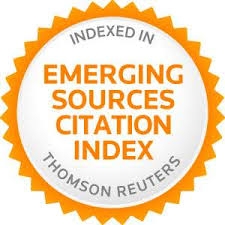The Orton's hypothesis about hemispheric lateralization and reading writing performance revisited: an ex post facto study in Spanish context
Resumen
This paper attempts to inquiry the connections between hemispherical laterality and reading-writing performance, based on the theory that Samuel T. Orton established over 60 years ago. No evidence has been found to show a significant correlation between both constructs. Therefore, the widely held belief that the one depends on the other can be refuted.
Palabras clave
Texto completo:
PDFReferencias
Aliaga, F. (2000). Validez de la investigación causal. Tipologías y evolución. Bordón, 52 (3), 301-321
ALEGRIA, J. (1985). Por un enfoque psicolingúístico del aprendizaje de la lectura y sus dificultades [A psycholinguistic focus for the learning of reading and its dificulties]. Infancia y Aprendizaje, 29, 79-94.
http://dx.doi.org/10.1080/02103702.1985.10822061
Boder, E. (1970). Developmental dyslexia. A new diagnostic approach based on the identification of three subtypes. Journal of School Health, 40, 2-89.
Campbell, D.T. (1986). Relabeling Internal and External Validity for Applied Social Scientist. En W. Trochim (Ed.),Advances in Quasi-Experimental Design and Analysis. San Francisco: Jossey-Bass.
Cook, T. D. y Campbell, D. T. (1979). Quasi-Experimentation Design and Analysis Issues for Fields Settings. Chicago: Rand McNally.
Dixon, W. J. (Ed.) (1990). BMDP statistical software. Los Angeles: University of California Press.
Fernández Cano, A. (1995). Métodos para evaluar la investigación en Psicopedagogía [Methods for evaluating psycopedagogical research]. Madrid: Síntesis.
Fraenkel, R., & Wallen, N. E. (1990). How to design and evaluate research in education. New York: McGraw-Hill.
Harris, A. J. (1978). Test de dominancia lateral [Laterality dominance test], 3rd edn. TEA: Madrid.
HENRY, M. K. (1998). Structured, sequential, multisensory teaching. The Orton legacy. Annals of Dyslexia, 48, 3-26.
http://dx.doi.org/10.1007/s11881-998-0002-9
Hernandez, S.; Camacho, J.; Nieto, A.; & Barroso, J. (1997). Cerebral asymmetry and reading performance. Effect of language lateralization and hand preference. Child Neuropsychology, 3(3), 206-225.
http://dx.doi.org/10.1080/09297049708400644
Hinshelwood, J. (1917). Ceguera congénita ante las palabras [Congenital blindness to the words]. In R. G. Crowder (ed.), Psicología de la lectura [Psychology of reading], (1985), (pp. 201-203). Madrid: Alianza.
Kounios, J., & Holcomb, P. J. (1994). Concreteness effects in semantic processing: ERP evidence supporting dual coding theory. Journal of Experimental Psychology, 20, 04-823.
Lenneberg, E. H. (1967). Biological foundations of language. New York: Wiley. Spanish traslation as Fundamentos biológicos del lenguaje (1985), 2nd edn. Madrid: Alianza.
Machuca, M. (1996). Lateralidad hemisférica y dominios lectoescritores. La hipótesis de Orton revisada [Hemisferic laterality and reading-writing domains. The Orton's hypothesis revisited]. Barcelona: ETD Micropublicaciones.
Manga, D. & Ramos, F. (1986). La aproximación neuropsicológica a la dislexia evolutiva [The neurological approach to the developmental dyslexia]. Infancia y Aprendizaje, 34, 57-75.
Mark, M. (1986). Validity Typologies and the Logic and Practice of Quasi-experimentation. En W. Trochim (Ed.), Advances in Quasi-Experimental Design and Analysis. San Francisco: Jossey-Bass.
Myklebust, H. R., & Johnson, D. (1962). Dyslexia in children. Exceptional Children, 9(1), 14-25.
Navarro, N., Iglesias, E. & Caballero, P. (1990). La lateralización hemisférica de funciones como proceso mediador del aprendizaje en el aula [The hemisferic lateralization of functions as a mediator process for the learning in the classroom]. Revista de Investigación Educativa, 8(16), 143-147.
Oakland, T., Black, J. L., Stanford, G., Nussbaum, N. L. & Balise, R. R. (1998). An evaluation of the dyslexia training program. A multisensory method for promoting reading in students with disabilities. Journal of Learning Desabilities, 31(2), 140-147.
http://dx.doi.org/10.1177/002221949803100204
Oldfield, R. C. (1971). The assessment and analysis of handedness: The Edinburg inventory. Neuropsychologia,9, 7-113.
http://dx.doi.org/10.1016/0028-3932(71)90067-4
ORBRZUT, J. E., BOLIEK, C. A. & BRYDEN, M. P. (1997). Dichotic-listening, handedness, and reading-ability. A metaanalysis. Developmental Neuropsychology, 13(1), 97-110.
http://dx.doi.org/10.1080/87565649709540670
Orton, S. T. (1928a). A physiological theory of reading disability and stuttering in children. The New England Journal of Medicine,199, 1046-1052.
http://dx.doi.org/10.1056/NEJM192811221992108
Orton, S. T. (1928b). Specific reading disability strephosymbolia. Journal of American Medical Association,90, 1095.
http://dx.doi.org/10.1001/jama.1928.02690410007003
Orton, S. T. (1937). Reading, writing and speech problems in children. Nueva York: Norton.
Orton, S. T. (1939). A neurological explanation of the reading disability. Education Record 20(12), 58-68.
Romero, A. (1984). La especialización funcional hemisférica y la lectura. Una revisión teórica [The hemisferic functional specialization and reading. A theoretical review]. Anales de Psicología, 1, 181-206.
Shadish, W.; Cook, T.D. y Houts, A. (1986). Quasiexperimentation in a Critical Multiplist Mode. En W. Trochim (Ed.), Advances in Quasi-Experimental Design and Analysis. San Francisco: Jossey-Bass.
Shavelson, R. J. (1988). Statistical reasoning for the behavioral sciences. 2nd ed Boston: Allyn & Bacon.
Vellutino, F. (1987). Dislexia [Dyslexia]. Investigación y Ciencia [Research and Science] 128: 12-20.
Enlaces refback
- No hay ningún enlace refback.


